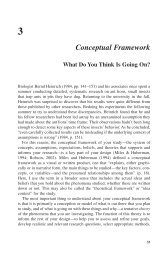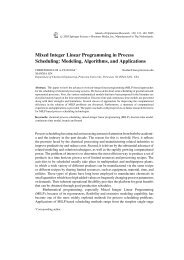R7.1 Polymerization
R7.1 Polymerization
R7.1 Polymerization
You also want an ePaper? Increase the reach of your titles
YUMPU automatically turns print PDFs into web optimized ePapers that Google loves.
Termination<br />
Initiation<br />
Propagation<br />
Transfer<br />
Termination<br />
363<br />
Termination.<br />
mechanisms:<br />
Chap.<br />
Termination to form dead polymer occurs primarily by two<br />
1. Addition (coupling) of two growing polymers:<br />
2. Termination by disproportionation:<br />
For example,<br />
R j<br />
The steps in free-radical polymerization reaction and the corresponding<br />
rate laws are summarized in Table <strong>R7.1</strong>-1. For the polymerization<br />
of styrene at 80�C<br />
initiated by 2,2-azobisisobutyronitrile, the<br />
rate constants4<br />
are<br />
k0<br />
� 1.4 � 10�3<br />
s�1<br />
R j<br />
kp<br />
� 4.4 � 102<br />
dm3/mol�s<br />
ks<br />
� 2.9 � 10�3<br />
dm3/mol�s<br />
� Rk ⎯⎯→ P j<br />
km<br />
� 3.2 � 10�2<br />
dm 3/mol�s<br />
kta<br />
� 1.2 � 108<br />
dm3/mol�s<br />
ktd<br />
� 0<br />
Typical initial concentrations for the solution polymerization of styrene are<br />
0.01 M for the initiator, 3 M for the monomer, and 7 M for the solvent.<br />
<strong>R7.1</strong>.2.2 Developing the Rate Laws for the Net Rate<br />
of Reaction<br />
We begin by considering the rate of formation of the initiator radical I.<br />
Because there will always be scavenging or recombining of the primary radicals,<br />
only a certain fraction f will be successful in initiating polymer chains.<br />
Because each reaction step is assumed to be elementary, the rate law for the<br />
formation of the initiator free radicals, r If, is<br />
�k<br />
4 D. C. Timm and J. W. Rachow, ACS Symp. Ser. 133, 122 (1974).<br />
k<br />
td<br />
k<br />
ta<br />
�Rk ⎯⎯→ P j�<br />
H H<br />
( CH3) 2CCH ( 2CHCl)<br />
j CH2C � C�CH2( CH2CHCl) k ( CH3) 2C CN Cl Cl CN<br />
H<br />
H<br />
(CH 3) 2C(CH 2CHCl) j CH � C�CH(CH 2CHCl) k(CH 3) 2 C<br />
P<br />
k<br />
CN Cl Cl<br />
CN
















